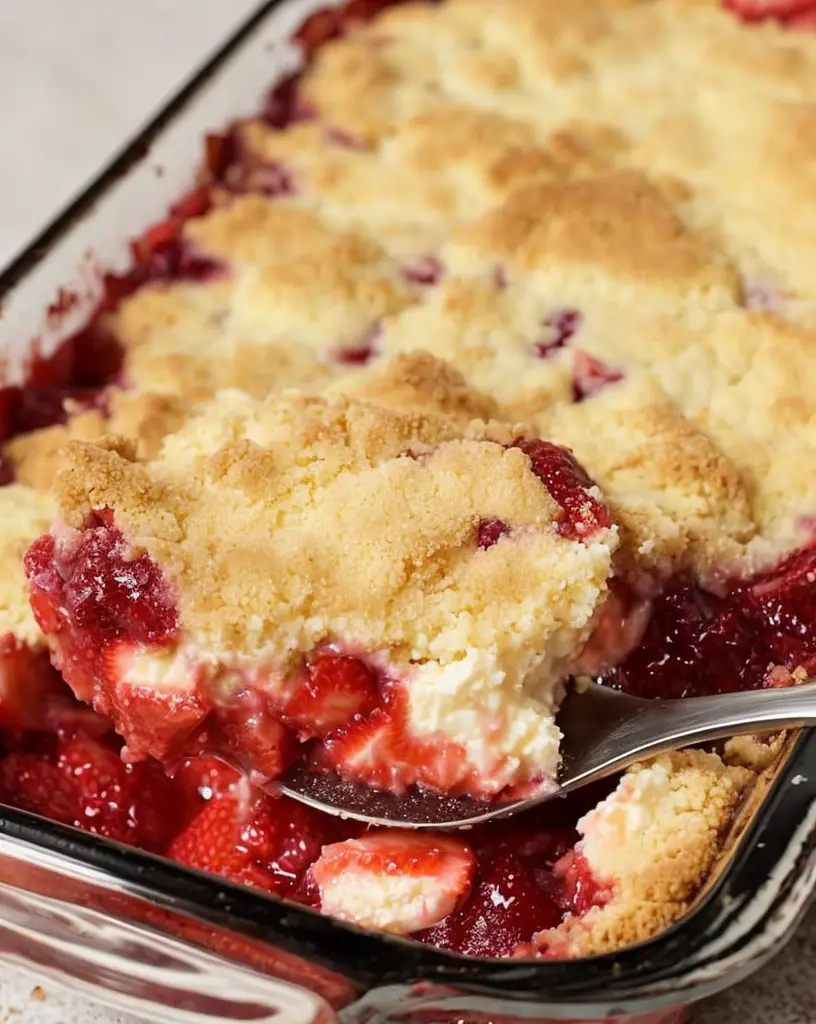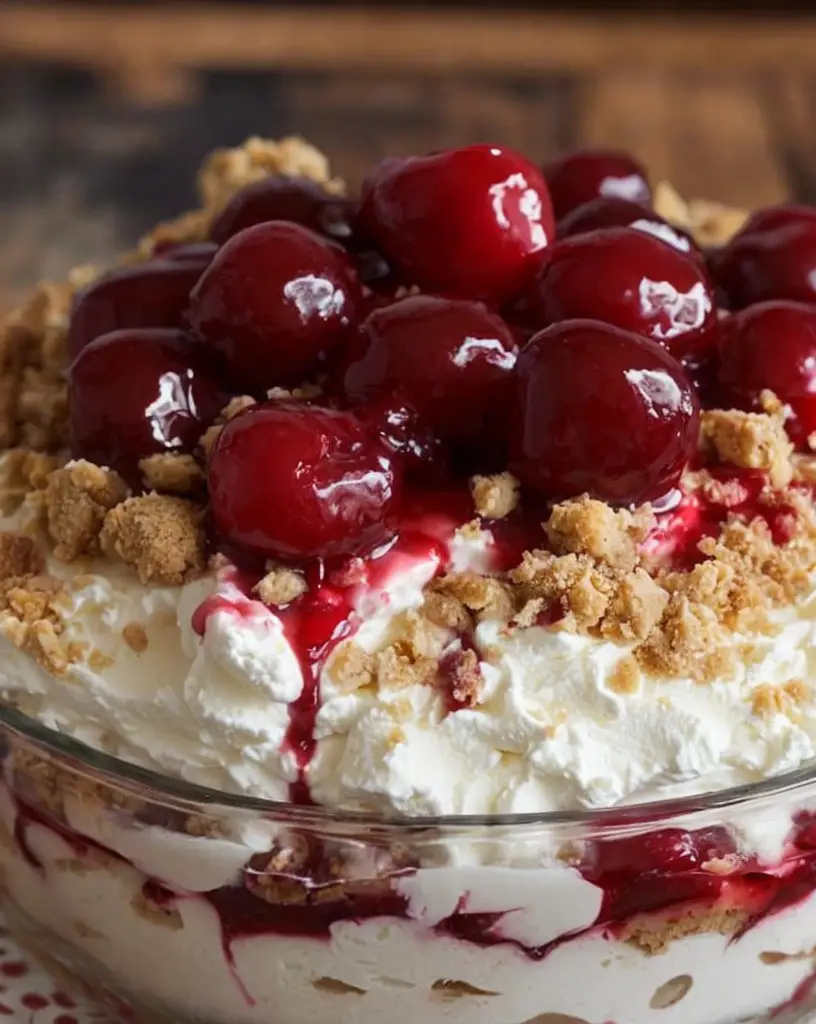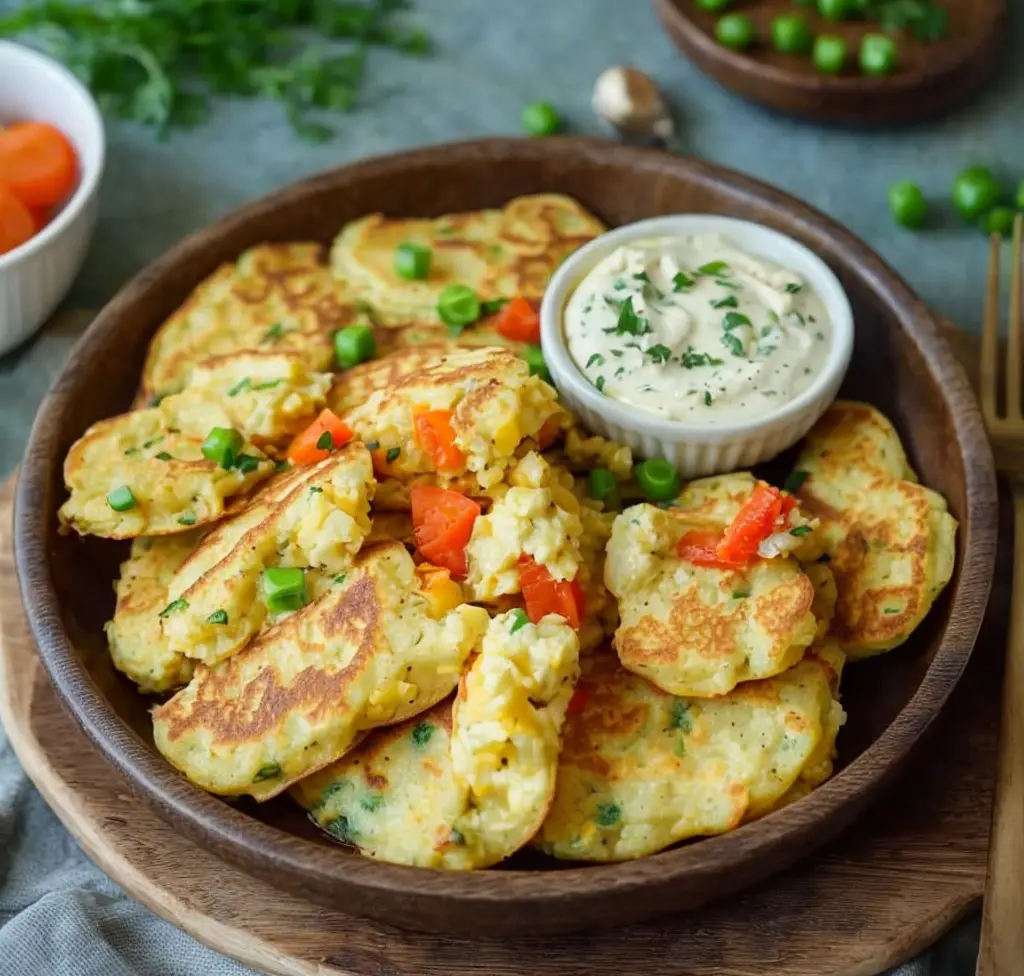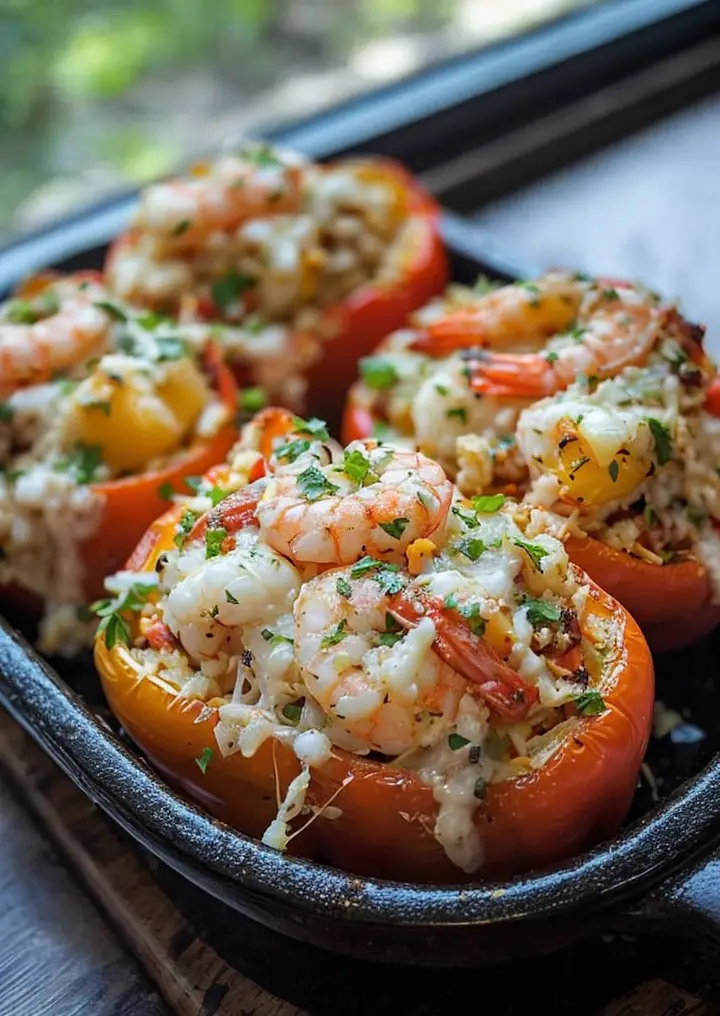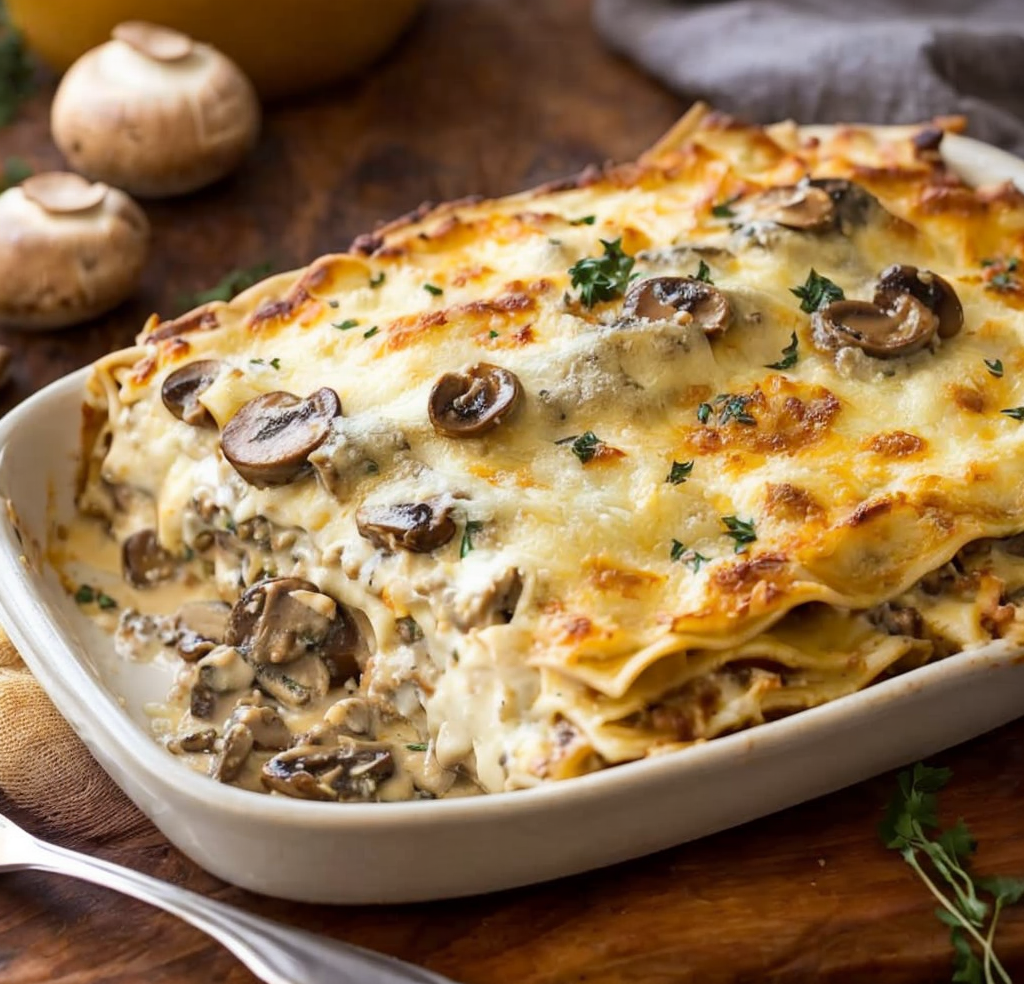Delicious Strawberry Cheesecake Dump Cake: A Sweet Delight
This Strawberry Cheesecake Dump Cake is the perfect blend of fresh strawberries and creamy cheesecake, topped with a buttery cake layer. It’s an effortless dessert that comes together quickly and relies on the delicious flavor of ripe strawberries to shine. Imagine digging into a warm slice of this creation, where each bite reveals a soft, sweet base complemented by the velvety texture of cheesecake filling. Whether you’re celebrating a special occasion or just satisfying a sweet tooth, this dessert will leave everyone asking for seconds.
Not only is this dessert delicious, but it’s also incredibly easy to make—no baking expertise is required. Just layer the ingredients, and let your oven do the magic. The delightful aroma of strawberries mingling with the warm cake fills your kitchen, setting the perfect ambiance for family time. This comforting dessert not only presents beautifully on the table but also brings warmth to the heart as you share it with loved ones.
Quick Recipe Highlights
- Flavor Profile: The combination of tangy cream cheese and sweet strawberries creates a perfect flavor balance that’s both refreshing and indulgent.
- Texture: Enjoy a delightful contrast between the fluffy cake layer on top and the creamy, rich cheesecake underneath.
- Aroma: The sweet scent of strawberries baking alongside buttery cake is undeniably inviting.
- Visual Appeal: This dessert boasts vibrant red strawberries peeking through a golden, crumbly layer, making it a stunning addition to any spread.
- Skill Level Needed: This recipe is accessible for all skill levels—perfect for beginners or seasoned bakers looking for a quick win.
- Special Equipment: All you need is a baking dish and a mixing bowl—no fancy gadgets required!
Recipe Overview
- Difficulty Level: Making Strawberry Cheesecake Dump Cake is simple enough for anyone to master, as it involves minimal steps, which makes it a go-to recipe for potlucks and family gatherings.
- Category: This dessert fits perfectly into the dessert category, fulfilling those sweet cravings while being versatile enough for any occasion.
- Cuisine: While this dessert can be traced back to classic American desserts, its universal appeal makes it popular in various culinary traditions, merging the flavors of cheesecake and fruit.
- Cost: Depending on seasonal availability, this recipe is quite economical, as strawberries and other ingredients can be bought at reasonable prices.
- Season: The best time to enjoy this cake is during the strawberry season, which typically spans late spring and early summer, ensuring the fruits are ripe and bursting with flavor.
- Occasion: Ideal for celebrations, family gatherings, and summer picnics, it’s a dessert that brings joy to any event.
Why You’ll Love This Recipe
The delightful taste and texture of Strawberry Cheesecake Dump Cake will make it a favorite among your family and friends. The creamy cheesecake layer pairs perfectly with the strawberry topping, creating a dessert that is both satisfying and refreshing. The ease of preparation and the minimal ingredients required make it a convenient choice for busy days or sudden cravings.
Not only is this dessert delicious, but it also has some nutritional advantages due to the fruit content. Strawberries are rich in vitamins and antioxidants, providing a healthier aspect to your dessert indulgence. When serving this cake, it has a social and entertaining value, sparking conversations and smiles, making it a hit at any gathering.
Cost-effectiveness is just another bonus, as you can prepare this delicious dessert without breaking the bank. Using in-season strawberries can greatly reduce costs while enhancing the flavor, making this dessert both accessible and approachable.
Historical Background and Cultural Significance
Strawberry cheesecake has a rich history that traces back to the ancient Greeks, who first created a cheese-based dessert. Over the centuries, recipes evolved, leading to the modern cheesecake we know today. The incorporation of strawberries adds a delightful twist and a refreshing element.
Culturally, this dessert is significant in many American households, often associated with summer barbecues and family reunions. The striking colors and flavors symbolize warmth, joy, and togetherness during these special occasions.
The evolution of the recipe has led to various adaptations and innovations, like the dump cake variety we have today, where the ingredients are layered and baked without the need for extensive preparation. This unique take has made it a beloved choice among home bakers looking for a quick and delicious dessert.
Regional variations are also quite common, with some regions adding their local fruits or flavors, showcasing how versatile and enjoyable this dessert can be.
Ingredient Deep Dive
- Strawberries: Strawberries are not only a staple in desserts but also carry cultural significance as symbols of summer and warmth. Nutritionally, they are low in calories and rich in fiber, vitamins C and K, and antioxidants. When selecting strawberries, look for bright red, firm berries with no green or white patches. For storage, keep them unwashed in the refrigerator for up to a week. For an alternative, consider using other berries like blueberries or raspberries.
- Cream Cheese: This key ingredient provides richness and creaminess to the cheesecake layer. Cream cheese has a long history in American desserts, often used in cheesecakes and frostings. It’s a good source of protein, but when choosing, go for blocks rather than spreads for a thicker consistency. Store cream cheese in the refrigerator and use within a few weeks of opening. For a lighter version, use low-fat or Neufchâtel cheese as a substitute.
- Cake Mix: The versatility of cake mix allows for easy preparation and can drastically cut down baking time. Cake mixes have been popularized in the 20th century, making baking accessible to all. Opt for a yellow or white cake mix for best results in this recipe. Cake mixes can be stored in a cool, dry place for a long time, making them a pantry staple. You can also make your own cake mix from scratch using flour, sugar, baking powder, and salt.
Common Mistakes to Avoid
- Using underripe or overripe strawberries can interfere with overall taste—choose strawberries that are fresh, bright, and firm.
- Not letting the cream cheese soften before mixing can result in a lumpy texture; always bring it to room temperature.
- Skipping the layer technique may cause thick spots instead of a cohesive texture, so ensure layers are well distributed.
- Overmixing the batter can lead to dense rather than fluffy cake—mix just until incorporated.
- Baking at incorrect temperatures can yield undesired results; always preheat your oven and check that it’s calibrated.
- Not checking for doneness can leave you with undercooked layers; a toothpick should come out clean from the center when done.
- Using a pan that is too small can cause spillage and even uneven baking; ensure you use the recommended size.
- Not allowing the cake to cool slightly before serving can cause it to crumble or fall apart; let it set for at least 10 minutes.
- Neglecting to double-check ingredient measurements can result in off flavors and textures; precision is key in baking.
- Forgetting to prepare your pan can lead to sticking; make sure to grease it properly to allow for easy removal.
Essential Techniques
Using the layering technique is crucial in this dump cake to achieve the desired texture. Start by evenly distributing ingredients to ensure all flavors blend harmoniously. When mixing the cheesecake layer, it is essential to whip until smooth, incorporating enough air to keep it light. Remember to avoid overmixing, as this can lead to a denser texture.
Pay attention to oven temperature and time. This recipe requires patience; allow the cake to cool appropriately to maintain its shape. The visual cues, like a golden crust on top and bubbling around the edges, are indicators that your cake is ready to be taken out.
Pro Tips for Perfect Strawberry Cheesecake Dump Cake
– Always select the freshest strawberries to elevate the dessert’s flavor; visiting a local farmer’s market can yield the best picks.
– Enhance flavor by adding a teaspoon of vanilla extract to the cream cheese mixture for an extra layer of depth.
– Allow the dump cake to cool before serving for better slicing; this avoids a messy presentation.
– For added crunch, consider sprinkling toasted nuts over the top just before serving.
– If you enjoy a tart flavor, a drizzle of balsamic reduction over the final presentation can complement the dessert beautifully.
– Storing leftovers in an airtight container in the fridge will keep it fresh for several days.
– For variations, incorporate lemon zest into the cheesecake layer for a refreshing twist.
– Transform your dump cake into individual servings by layering it in jars for a beautiful presentation.
Variations and Adaptations
This Strawberry Cheesecake Dump Cake is wonderfully versatile. For regional variations, consider swapping strawberries with other summer fruits, such as peaches or cherries, to create a different flavor experience. Seasonal adaptations allow you to adjust the recipe according to what’s fresh, giving you creative leeway year-round.
Dietary modifications are also an excellent approach; for gluten-free options, use gluten-free cake mix, and for dairy-free versions, alternative cream cheeses can easily be swapped in. Flavor variations may include adding a pinch of cinnamon or almond extract to enhance the existing flavors.
You can also play around with texture; integrate crushed cookies or graham cracker crumbs into the topping before baking. For a sophisticated touch, serve the dessert in elegant dishware with a dollop of whipped cream on top.
Serving and Presentation Guide
Plating techniques for this dump cake can elevate your dessert experience. Consider using a large, flat spatula to serve pieces onto plates, showcasing the layers beautifully. Garnishing ideas might include fresh mint leaves or a dusting of powdered sugar for a visually appealing finish and enhanced flavor.
Traditional accompaniments include a scoop of vanilla ice cream or a drizzle of whipped cream. Modern serving suggestions could involve presenting in individual cups or jars to offer guests a personal touch. Temperature considerations are essential as well; serving the cake warm with cold toppings provides a delightful contrast.
Lastly, portion control tips suggest cutting slices into smaller sizes if served as part of a larger dessert table, allowing guests to sample various options.
Wine and Beverage Pairing
When pairing wine with Strawberry Cheesecake Dump Cake, consider a sweet dessert wine, such as Moscato or Riesling, that enhances the fruity flavors. If you prefer a non-alcoholic alternative, a refreshing strawberry lemonade or iced herbal tea can complement the dessert beautifully.
If coffee or tea is preferred, opt for a creamy cappuccino or a light chamomile tea, which pairs well with the rich cheesecake flavors. Temperature considerations play an essential role; beautifully chilled wines or warm beverages offer a delightful contrast to the cold dessert.
Serving suggestions include using vintage glassware for the wine or unique cups for the iced drinks, enhancing the overall dining experience.
Storage and Shelf Life
Proper storage methods are crucial to maintaining the quality of the Strawberry Cheesecake Dump Cake. After cooling, store it in an airtight container in the refrigerator to keep it fresh for up to 3-4 days. Ensure the cake is well-covered to prevent drying out and exposure to other fridge odors.
For reheating, gently warm individual slices in the microwave for a few seconds. The cake can also be frozen; wrap tightly in plastic wrap and then in aluminum foil, which keeps it fresh for up to 3 months. When thawing, leave it in the refrigerator overnight for best texture maintenance.
Watch for signs of spoilage, including a sour smell or mold growth, which could suggest the cheesecake layer has gone bad. If you didn’t eat it all before it loses quality, repurposing leftover cake into a trifle can be a delicious option.
Make Ahead Strategies
To streamline your preparation, consider making the strawberry topping ahead of time. Store it in the refrigerator, allowing the flavors to meld beautifully, while preparing the cheesecake layer can also be completed a day in advance. This minimizes the day-of workload significantly.
Assembly tips include layering the cake mix, strawberries, and cheesecake mixture just before baking to ensure freshness. Once baked, store the cake in the refrigerator until ready to serve, as it holds well overnight.
Quality impact assessment shows that fresh strawberries maintain their flavor and texture better if added just before baking. For reheating, ensure you bring it to room temperature before placing it in the oven to avoid shock.
Scaling Instructions
Scaling this recipe is easy and can accommodate various gatherings. For halving the recipe, simply divide each ingredient by two and use a smaller pan for baking. If doubling or tripling, increase the ingredients proportionately but consider larger baking sheets to prevent overflows.
Equipment adjustments may be necessary; larger mixers can accommodate larger batches more efficiently, which reduces preparation time. Timing modifications should account for additional cooking time, so check for doneness by inserting a toothpick into the center as baking times may vary.
Storage considerations become essential if you plan on making multiple batches—label containers to help keep track of each variation for best management.
Nutritional Deep Dive
Analyzing macro breakdown, this dessert includes healthy fats from cream cheese, carbohydrates from the cake mix, and natural sugars from strawberries. The creamy layer offers protein content, while the fruity topping provides fiber.
Micronutrient analysis reveals significant amounts of vitamins and antioxidants, particularly from strawberries, which contribute to heart health and improved immune function. Making dietary considerations easier, this dessert can be tweaked for specific dietary needs, maintaining delicious flavors while fulfilling nutritional requirements.
Portion analysis ensures you enjoy this dessert without guilt; a standard serving can easily fit within a balanced diet when paired thoughtfully with other meals. Weight management tips suggest enjoying smaller portions or adding fresh fruit to enhance volume without added calories.
Dietary Adaptations
This Strawberry Cheesecake Dump Cake can easily cater to various dietary restrictions. For gluten-free options, select a gluten-free cake mix and ensure all other ingredients are certified gluten-free. For dairy-free adaptations, non-dairy cream cheese can successfully replace traditional cream cheese, making it vegan-friendly.
Low-carb enthusiasts can substitute low-carb sweeteners for sugar and incorporate almond flour for the cake mix, creating a cake indulgence that aligns with keto requirements. For those on a paleo diet, using almond flour for the cake base can maintain the dessert’s integrity while keeping it compliant.
If you’re avoiding FODMAPs, replace strawberries with servings of blueberries and ensure any cream cheese substitutes fit your dietary profile, allowing for a delicious treat that considers individual dietary needs.
Troubleshooting Guide
Should you encounter texture issues, ensure cream cheese is blended until smooth before mixing with other ingredients. If you find that your cake is too dense, it might be due to overmixing—aim for gentle folding rather than vigorous stirring.
For flavor balance, taste the strawberry mixture before baking; if it seems bland, a touch of sugar or lemon juice can elevate flavors remarkably. Temperature problems arise when ovens are not calibrated properly—always invest in an oven thermometer for accuracy.
Ingredient substitutions can lead to unexpected results, so whenever trying a new ingredient, start with small batches to see how the flavors meld. Timing concerns during baking can often be solved with careful monitoring, ensuring doneness is achieved without burnt edges or undercooked centers.
Recipe Success Stories
Community feedback for this Strawberry Cheesecake Dump Cake is overwhelmingly positive, with readers praising its simplicity and delightful flavor. Sharing variations such as added spices or pecans gives others inspiration to try their unique spins on the classic dessert.
Adaptation stories highlight how readers have transformed the recipe to meet seasonal availability; many have had success using peaches in the summer or apples during fall.
Photography tips suggest presenting the dump cake on beautiful heirloom plates, with a scoop of ice cream, to create appetizing visuals that draw attention and compliments alike.
Frequently Asked Questions
How do I know when the cake is done? The cake is done when golden brown and a toothpick inserted in the center comes out clean.
Can I make this dessert vegan? Absolutely! Use non-dairy cream cheese and a vegan cake mix for a delicious vegan-friendly option.
Is it okay to prepare this dessert the night before? Yes, this cake can be assembled in advance and baked the next day for convenience.
Can I reduce the sugar in this recipe? Yes, you can adjust the sugar to your taste, but be mindful that it may affect the final texture and sweetness.
How should I store leftover cake? Store leftovers in an airtight container in the refrigerator for up to four days for best freshness.
Can I add other fruits to the cake? Yes, feel free to add berries, peaches, or even tropical fruits to customize your flavor experience.
What kind of pan should I use? A 9×13-inch baking dish is recommended for even cooking.
Can I freeze the dump cake? Yes, you can freeze it once baked and cooled. Wrap tightly in plastic wrap before placing it in the freezer for optimal freshness.
How long will the cake last in the fridge? It should last about 3 to 4 days in the refrigerator but is best enjoyed fresh.
Additional Resources
To expand your dessert repertoire, explore related recipes like classic cheesecake, fruit cobbler, or easy dump cakes with other fruits. Technique guides on baking basics can enhance your skills and confidence in the kitchen, while ingredient-specific information will help you make the most out of fresh produce.
Investing in essential kitchen equipment can enhance your baking experience, so check out mixers or quality bakeware. Seasonal variations invite you to adjust ingredients based on what’s in season, delivering the freshest flavors to your table.
Join the Conversation
We encourage you to share your experiences with Strawberry Cheesecake Dump Cake! Snap pictures of your creations and share them on social media with relevant tags for a chance to connect with fellow bakers.
Leave your reviews and feedback, as community engagement enriches the recipe experience, bringing new adaptations and inspirations to light. Don’t hesitate to suggest your unique variations; sharing ideas helps everyone improve their baking journeys.
The Recipe
Strawberry Cheesecake Dump Cake
Serves: 8 servings
Prep Time: 15 mins
Cook Time: 45 mins
Total Time: 60 mins
Kitchen Equipment Needed
- 9×13-inch baking dish
- Mixing bowls
- Measuring cups and spoons
- Spatula
Ingredients
- 1 pound fresh strawberries, hulled and sliced
- 8 ounces cream cheese, softened
- 1 cup sugar
- 1 teaspoon vanilla extract
- 1 box yellow cake mix
- 3/4 cup unsalted butter, melted
- 1/4 cup milk
Directions
- Preheat the oven to 350°F (175°C).
- Spread sliced strawberries evenly in the bottom of the baking dish.
- In a bowl, beat together cream cheese, sugar, and vanilla until smooth. Spread over the strawberries.
- In another bowl, combine the cake mix, melted butter, and milk. Pour this mixture over the cream cheese layer.
- Bake for 45 minutes, or until the top is golden brown and a toothpick comes out clean.
- Let cool for 10 minutes before serving.
Recipe Notes
- Feel free to substitute other berries for a different flavor!
- Add lemon zest for a slightly zesty kick.
- Store leftovers in the refrigerator for up to 4 days.
